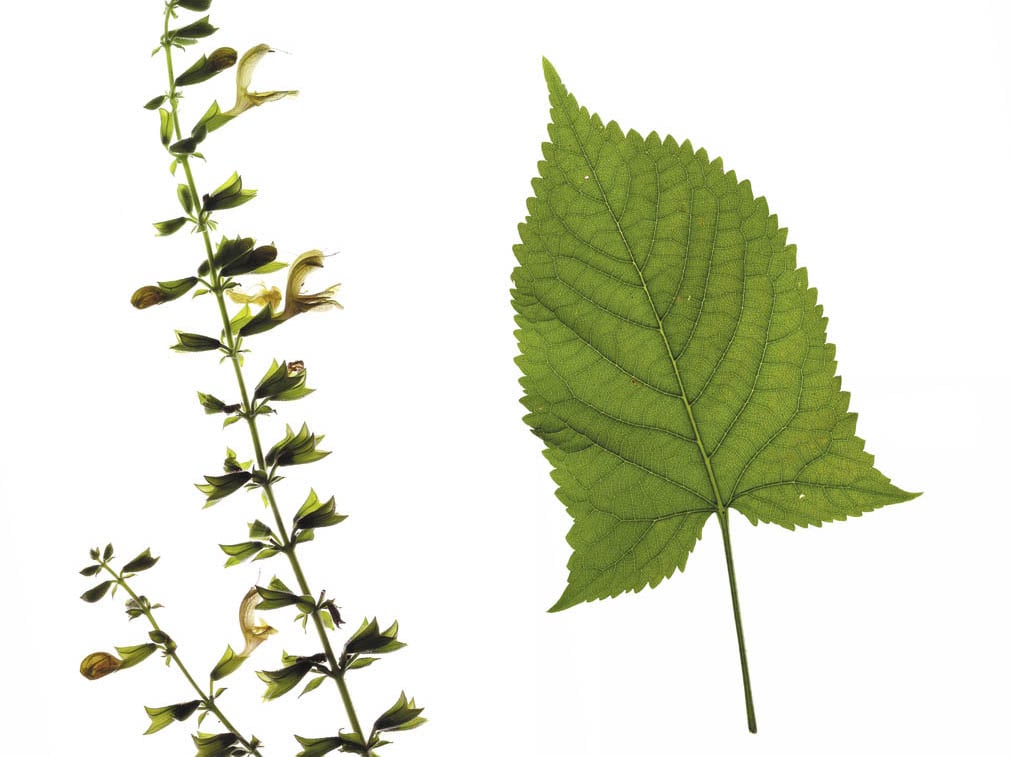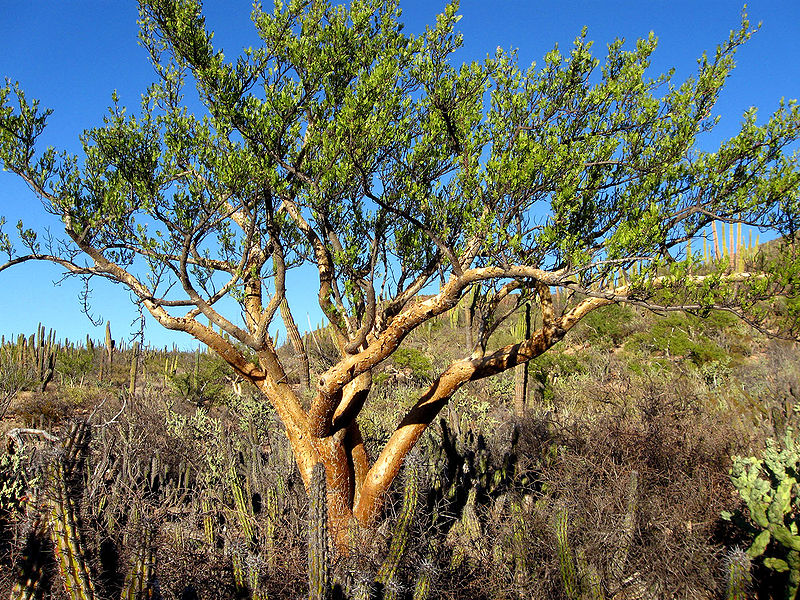

Contributor
- Topics: Archive
Those charming spots of high shade in the garden, where your head and eyes are protected from glaring sunlight, are more likely than not difficult areas for plants to flourish. Pools of high shade are captivating and can be wonderful places to stop for a few moments to enjoy plants close at hand, as well as to savor a view across the garden. But what plants can be inspected nearby and yet not obstruct the scene? Groundcovers? Yes, ajugas and others can thickly cover such an area, remaining low and unobtrusive. When our imagination comes into play, however, other plants become likely candidates. I recommend three salvias, all with pale yellow flowers, for these most agreeable areas.
Consider a plant that reaches from one to three feet in height and a little more in width, with good green foliage. Soft yellow flowers add their charm for about a month or so. Two of the salvias, from different parts of the world, are sometimes confused with one another, but, as you will see, their characters are easily distinguished, whether the plants are flowering or not. A third yellow-flowered contender for summertime shade has a lax rather than an upright habit.

Salvia glutinosa
Found across Europe and western Asia, Salvia glutinosa usually occurs in mountainous regions, in protected environments near woodland edges. Described by Linnaeus in 1753, S. glutinosa was known long before that date in central Europe for its pleasingly scented glands; the specific name, glutinosa, refers to this attribute. Both flowers and calyces are covered with glands and were used along with the leaves to flavor wine. The plant’s common name is Jupiter’s distaff (Jupiter’s wife), Jupiter being the supreme god of the ancient Romans who controlled the heavens and weather—and, consequently, controlled the production and festivals of wine.
A deciduous perennial, Salvia glutinosa is a rangy plant. Sometimes reaching three feet (one meter) in height, it usually attains only two feet (sixty centimeters). Graduated and hairy, the hastate (arrow-shaped) leaves are widely spaced along the stem. They are parsley green in color with petioles that are almost as long as the leaf itself. The leaf margin is clearly dentate, with coarse teeth that point outward. The inflorescence is about one foot (thirty centimeters) in length, with pale yellow flowers in whorls of two to six. The upper lip of the attractive flower is flecked with tiny maroon dots. The closest description of the flower color, using the Royal Horticulture Society’s Colour Chart, is Yellow Group 9C for the corolla, with dots of Red-Purple Group 59B on the upper lips. Flowering begins in early summer and, though it may be abundant, can be overlooked because of the flower’s delicate color. Deadheading spent inflorescences before seed production will stimulate flowering for a longer period of time, possibly well into the autumn.
A location with high shade and free-draining, friable garden soil containing lots of humus offers ideal conditions for growing Salvia glutinosa. Weekly watering during dry summers is recommended for this cold tolerant plant. It is reported to withstand temperatures below 0° F (-18° C). In late autumn or early winter, when tidying the garden, be sure to remove the season’s top growth to prevent fungal activity in the plant’s crown during winter. Propagate by seed or cuttings taken in late summer.

Salvia nubicola
Known in the wild for appearing in a variety of habitats, including sunny slopes, Salvia nubicola has proven to adjust exceptionally well to conditions of high shade in the garden. A deciduous perennial found at low and high elevations, its specific epithet, nubicola, means “dweller among clouds.” Its distribution extends from Afghanistan through southwestern Asia to Bhutan. Brought to the United States and Europe from various collecting trips in Asia, it is well established in horticulture both here and abroad.
The erect stems of Salvia nubicola sometimes reach three feet (one meter) in height but more often are less than that. The fresh green leaves are well spaced along the stem, triangular in outline, and held on a petiole that is about the same length as the leaf.
Flowering begins in summer, and, if the inflorescences are deadheaded, a second flowering will follow. Pale yellow, two-lipped flowers, with a cleft in the lower lip and reddish brown spotting on both lips, appear in whorls of two to six flowers. The nearest color of the flowers, using the Royal Horticulture Society’s Colour Chart is Yellow Group 10A, with markings of Greyed-Purple Group 184B. The bright green calyx is hairy and sticky, with glands that emit a light medicinal odor. Seed will mature in autumn and propagation, by cuttings taken in late August, will produce plants that can be held in a greenhouse for planting in the following spring.
High shade and quick-draining, humus-rich soil are the essential cultural requirements for Salvia nubicola, along with regular weekly water. Hardy to 0° F (-18° C), the stems should be removed at the end of autumn in order to prevent fungal activity and to ensure the health of the plant.
Botanically S. nubicola is related to S. glutinosa, although they do not occupy the same areas in the wild. The gardener can easily distinguish the more relaxed habit of S. glutinosa from the upright habit of S. nubicola. There are also differences in the leaves and flowers. The leaves of S. nubicola are thickish, whereas those of S. glutinosa are always thin. The lower lip of S. nubicola has a cleft in the center; on S. glutinosa, the lower lip is rounded.

Salvia koyamae
A handsome, lax perennial from Japan, Salvia koyamae is rarely found in the wild on Honshu, its native habitat and Japan’s largest island, where it is called shinano-akigiri. However, the Japanese have grown and nurtured this treasure in their gardens. It was discovered and appreciated by American plantsmen visiting Japan and, subsequently, came into cultivation in the United States in the 1990s.
With reclining stems that may reach two feet (sixty centimeters) in length, Salvia koyamae appears to creep through beds and borders, forming a loose ground cover. Little more than one foot (thirty centimeters) in height, the stems are covered with cordate (heart-shaped) leaves with a lush appearance. The leaves are yellow green in color, lightly covered with hairs, and held on a petiole that is almost as long as the leaf itself. The inflorescence is often over one foot (thirty centimeters) long; during late summer and early autumn, plants reach their heaviest blooming period. I have counted as many as eight inflorescences in full flower on a single plant in mid-September. The nearest color of the flowers, using the Royal Horticulture Society’s Colour Chart, is Yellow Group 12C.
Easy to establish and grow, Salvia koyamae needs deep, rich soil along with excellent drainage. Positioned under high shade and given a generous supply of water, this salvia will gracefully climb through and between low-growing plants. Temperatures in the range of 25° F (-4° C) for short periods of time cause no problems if plants have good drainage. Some pruning of the plant is advisable in late autumn, but early spring, after all danger of frost has past, is the time to give the plant a thorough cleaning to prepare for the coming season’s growth. Propagation is by seed or cuttings taken in late summer.
The West Coast’s magical mediterranean climate allows the gardener many opportunities for reveling in the planning, planting, and enjoyment of high shade areas. These three salvias are not fussy and can be planted in the garden throughout spring or autumn. A cool spell of weather in August or September is my favorite time for planting, because roots grow well at that time of year, and plants will quickly become established.
A Different Kind of Illustration:
Using a Scanner to Create Flower Images
JOANNE KOLTNOW
 I used a scanner to make the illustrations for the accompanying article. A simple explanation of how I did that reads like this: Place the plant material on the scanner. Make a scan and save it on the computer. Touch up the scan using Photoshop. Print.
I used a scanner to make the illustrations for the accompanying article. A simple explanation of how I did that reads like this: Place the plant material on the scanner. Make a scan and save it on the computer. Touch up the scan using Photoshop. Print.
The reality is a little more complex. Although my first scanner was a simple desktop model, I now use a professional scanner that has a twelve- by seventeen-inch bed and, instead of a conventional lid, a transparency adapter. When I’m scanning, the transparency adapter illuminates the material from above, so the image I get is of a flower backlit by light shining through it. And, having a large scanning surface means I can scan most plants without having to cut them to fit.
Several paths led me to the method I currently use. I had been doing close-up flower photography and liked the way a shallow depth of field allowed me to highlight one part of the flower and blur the rest. I had also been experimenting with scanning. Several years ago, after seeing what a fellow photographer achieved by putting flowers directly on her scanner, I tried the same thing. But I wasn’t hooked until I bought a scanner that had a four- by five-inch transparency adapter and started scanning tiny flowers.
When I looked at the transparent flower images floating on a white background, and saw the veins and edges, I realized that I had the tools to create something similar to the work of the early botanical illustrators. The final hurdle was determining the best resolution for printing. Although I wanted the images to be realistic, I was looking for the softness of a watercolor rather than the sharp edges of a high-resolution photograph. So I print most of my images at 170 to 180 dpi (dots per inch).
Scanning has made me look more closely at flowers than I ever did before—and it has changed me from being a “fruit-and-vegetable farmer” to being a gardener. It’s also encouraged me to think about public aspects of the relatively private act of making art.
Scanning Your Own Flowers
A scanner, with or without a transparency adapter, is a wonderful tool for capturing flower images. You may want to make a record of your garden plants—or, like me, decide to create flower art.
Here are some suggestions:
- Prop up the lid of the scanner so you don’t crush your flower.
- To get a dark background, remove the lid entirely and scan in a dark room—or cover the flower with a dark paper.
- Scan at a higher resolution than you think you’ll need for printing. Reducing the image size later is easy.
Here’s what I use:
- Macintosh G4 computer,
- Epson Expression 836XL scanner with transparency adapter,
- Epson Stylus Photo 750 printer,
- Epson Scan and Adobe Photoshop software.
Share:
Social Media
Garden Futurist Podcast
Most Popular
Videos
Topics
Related Posts

Ground Up Science for Greener Cities with Garden Futurist Dr. Alessandro Ossola
Spring 2023 Listen to the Podcast here. Alessandro Ossola is a scientist who gets very excited about the challenge of climate change allowing for an

Readying Urban Forests for Climate Realities with Garden Futurist Dr. Greg McPherson
Winter 2023 Listen to the Podcast here. “Going from the mow and blow to a more horticulturally knowledgeable approach to maintaining the landscape. And that

Welcome, Greywater, to the Garden
Summer 2022 Oh, summer: delightful warm air, tomatoes swelling on the vine, fragrant blooms on an evening stroll. When it’s warm and rainless, how is

Big Tree-Data and Big-Tree Data with Garden Futurist Matt Ritter
Summer 2022 Listen to the full Garden Futurist: Episode XV podcast here. We are in an environmental crisis right now in many parts of California









Responses